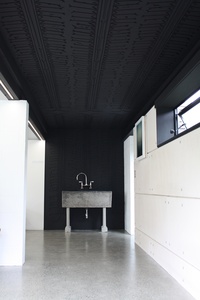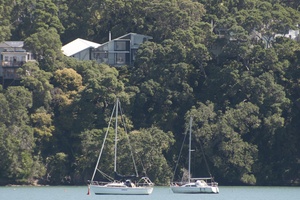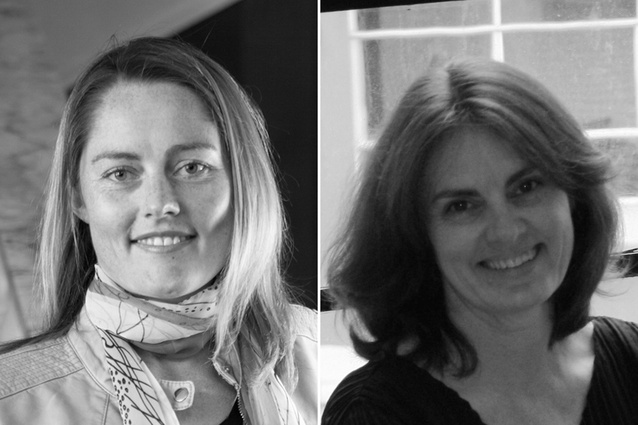Women in architecture #1
The first in a series of two, ArchitectureNow talks to architects Lynda Simmons and Vanessa Carswell about working in New Zealand. Lynda Simmons is one of the founders of the Architecture+Women•NZ organisation, a registered architect, author and educator. Vanessa Carswell is a principal at Warren and Mahoney's Christchurch studio, and is currently on her second stint of maternity leave.
Here, they discuss working as a female architect in New Zealand, and how challenges such as pay inequity and lack of senior representation could be tackled.

Amelia Melbourne-Hayward: What has been your experience of pay equity between women and men in architecture? Do you see this as a problem and, if so, what steps do you think we can take to improve the situation?
Lynda Simmons: New Zealanders have a history of fairness and equity, however that said, research shows that women earn 12 per cent less pay than men in New Zealand overall. In architecture that discrepancy often plays out through people on flexible hours at a lower rate.

I think it’s more of a part-time issue than a gender issue. Both males and females are affected – whoever goes into part-time work, it will be detrimental to their career. Practice culture can change to support men to take time out of work too, to share in family ‘care’ duties, then women will also benefit.
Vanessa Carswell: It’s a complex issue. Taking my cue from forums and surveys that have been conducted regarding professional pay, it certainly seems that women are paid less than men. Women are not often in the upper tiers of the profession, so that would affect the overall average income. A lot of women are more likely to be taking part-time roles, while some don’t desire to reach the top of the tree.
AMH: There are few females in senior management roles in medium-to-large architecture firms in New Zealand. Do you anticipate this changing?
LS: Yes it has to change; I’m an optimist! There are only approximately 1 per cent of women in senior roles at the moment. Architecture+Women•NZ (A+W•NZ) has been around for 5 years now and in that time we have seen change happen and heard stories of direct outcomes from the spotlight being shone on women.
As an example, our 2014 awards were structured in a way that somebody else nominates you for one of the awards. Directors then specifically looked at females in the team, and this act of generosity was a catalyst for that person to continue to be seen and valued for their work.

VC: Yes. I am one of two female principals appointed at Warren and Mahoney, and I know firsthand that perceptions are changing. There’s no point in trying to suggest that females and males are the same because we’re not! There is more of a realisation now that it’s advantageous to have both women and men in senior roles.
Women are often quite good at reading between the lines while communicating. In larger projects and companies there is a need to get the best from each individual through collaboration and teamwork across client, stakeholder and consultant groups. So leadership style becomes very important, you need everyone to give their best in terms of expertise and not let egos get in the way. Here, both females and males can bring something different to the table.
AMH: Are women architects more reluctant than their male counterparts to actively promote themselves and their work? If so, why do you think this is and how can women be empowered to ‘put themselves out there’?
LS: Women are definitely overlooked – we know that, from a review of our history, and there is anecdotally an element of holding back. A+W•NZ has visibility as one of its two core aims, and we encourage women to enter awards; it’s one of the biggest things to keep all architects visible. I always try to encourage women to put themselves forward, and try to give them an avenue that provides them with options to do that.
That said, I can think of many examples of men who don’t promote themselves also – I’m very wary of the statement that “women and men are different”, as this generalisation leads to the idea that female architects are somehow all similar, which is completely untrue. All women are not the same – the way I work is not the same as the next woman.
VC: I know that to be the case personally, yes. I am lucky in that I have a great support network of colleagues, family and friends who remind me that active promotion is important. For some it’s a natural thing and others not so much. You have to have confidence to get ahead, you need to want it just as much as others do and be vocal about it.

AMH: In an industry where a high percentage of clients are men (property developers, etc), does this affect the business environment and culture, as well as opportunities for women?
LS: The client base definitely affects the workplace and business culture and this has been previously male dominated, which has made a difficult working environment. This is changing however, women now feature strongly on education boards, councils etc, who definitely notice the lack of women architects.
The lack of women in senior roles is embarrassing for architecture as a whole. The client base itself is changing and they’re looking for a wider representation in the architectural team. However, while the clients are changing, the Universities have changed and the industry is slowly changing, the building site is the last place to change.
VC: It does have an effect, but I’ve never thought it was necessarily disadvantageous. I think we need to get over that notion. Women inherently tend to deal with things in a different way, and this can be an advantage.
AMH: The statistics show that more females than males are studying architecture at The University of Auckland today, do you think this will eventually translate to more women in senior roles in architectural practice?

LS: I’ve been involved in teaching at 3 universities over the last 20 years and there is no difference in the talent or outcomes across gender. However, after 5 to 10 years or so working in architecture the trajectory of males and females becomes very uneven – females are not following the same path that males do.
In part this could be caring for family but it is also happening to women who choose not to have children. You also see a discrepancy in who’s registered and who’s not – there is only 24 per cent female registration. At this stage, males are more likely to be in a position of leadership and women aren’t. There are a lot of different and complex reasons for this – a big one is part-time work.
Traditional structures in the architecture profession that are in place need to be updated. I firmly believe that to enable women to develop professionally in an equal way to their male colleagues, focus needs to be on helping men include ‘care’ duties into their lives.
This means a policy change for most architectural practices around flexible and part-time work hours, allowing men to take time to share caring duties for their families without it being detrimental to their careers. This shift may reduce any unconscious bias which exists now against women and their work.
VC: Yes, I think it’s inevitable. Women taking leave and not coming back to the workforce still seems to be a significant part of why there are fewer women in senior roles. Often the lower earner in a relationship will take on more child care duties. Therefore as pay equity improves, this will balance out.

Perceptions on childcare responsibility are certainly changing. At Warren & Mahoney Christchurch for instance, there are more men than women working part-time or flexible hours for reasons of childcare. Personally, I can say that Warren & Mahoney have been very good about maternity leave; they have been flexible about hours and working location, which is key when you’re returning to work.
It’s not just about salary any more – many professional employers are responding to the importance of flexible work terms to the modern workforce and both men and women need to take advantage of this.














